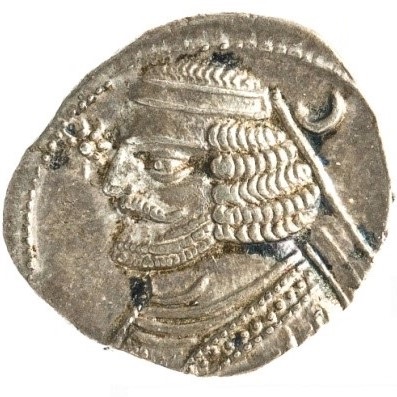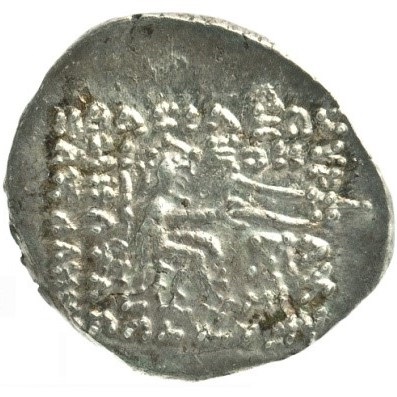Acquisition number: 1976.05
Obv.: Bust of Orodes l., bearded and moustached, wearing diadem, spiral necklace, ceremonial robe (the kandys). Behind, crescent; in front, star.
Rev.: Arsakes seated r. on throne, holding Parthian bow. Squared, seven-line inscription (partly illegible). Legible parts read ΒΑΣΙΛΕΩΣ ΒΑΣΙΛΕΩΝ (at the top); ΑΡΣΑΚ(ου) (at right, facing inwards); ΦΙΛΕΛΛΗΝ(ος) (at left, facing outwards): i.e., ‘of the king of kings, Arsakes, philhellene’. A mint mark is below the bow.
Title: Drachma of Orodes II of Parthia - 1976.05
Acquisition number: 1976.05
Author or editor: Douglas Kelly
Culture or period: Parthia.
Date: 57 - 38 BC.
Material: Metal - Silver
Object type: Coins - Greek
Dimensions: 20mm (w)
Origin region or location: Iran
Display case or on loan: 5
Keywords: Coin, Greek, Parthia, Parthian, drachma, Orodes II, Arsakes, Egypt, Crassus, Carrhae, Orodes
D. Sellwood, Parthian Coins (London, Pardy & Son, 1980), 47.9.
F.B. Shore, Parthian Coins and History: Ten Dragons against Rome (Quarryville, PA, Classical Numismatic Group, 1993), 239-247.
1976.05
Drachma of Orodes II of Parthia
Silver 4.06 g. 20 mm. 57-38 BC.
Obv.: Bust of Orodes l., bearded and moustached, wearing diadem, spiral necklace, ceremonial robe (the kandys). Behind, crescent; in front, star.
Rev.: Arsakes seated r. on throne, holding Parthian bow. Squared, seven-line inscription (partly illegible). Legible parts read ΒΑΣΙΛΕΩΣ ΒΑΣΙΛΕΩΝ (at the top); ΑΡΣΑΚ(ου) (at right, facing inwards); ΦΙΛΕΛΛΗΝ(ος) (at left, facing outwards): i.e., ‘of the king of kings, Arsakes, philhellene’. A mint mark is below the bow.
The drachma was one of the chief denominations of Parthian currency. It was of the Attic standard, at least until the end of the reign of Orodes, who ruled Parthia c. 57-38 BC. His portrait can be identified from two coins, one of which bears his name and another a date in his reign (the date according to the Seleukid era, beginning 312 BC). Arsakes (I) on the reverse of the coin) was the founder of the Arsakid dynasty, which ruled Parthia for nearly five centuries (c. 249 BC-AD 224). The bow is the characteristic weapon of the Parthians. This reverse type is the most common on all Parthian coins.
Orodes led a revival of Parthian power. Hostilities with Rome were caused partly by conflict over Rome’s eastern borders and client kingdoms (especially Armenia). Rome may also have wished to secure control over the trade routes from the Far East, from where it imported silk, spices, and ivory. In 53 BC at Carrhae (east of the Euphrates) Orodes’ army crushed the Roman army led by Crassus and captured the Roman standards. These were not recovered until Augustus’ time (20 BC), by diplomacy.
Under Parthian rule there was a duality in their territory between local (Iranian) traditions and Greek culture. In some respects, the Parthian kings saw themselves as heirs of the Achaemenids (Cyrus to Darius III, 550-330 BC), who had ruled this area before Alexander. They took over the old title ‘king of kings’ but also called themselves ‘philhellene’. (Orodes was reputedly listening to a reading from Euripides’ Bacchae when Crassus’ head was brought to him in 53 BC: Plutarch, Crassus 33).
Orodes’ obverse portraits are of high quality, but the reverses are often perfunctory and the legends illegible. The garbled nature of some of the coin inscriptions (as on the reverse of this coin) suggests a local workman who does not know Greek. The present reverse type reflects Parthian traditions associated with Arsakes I. Other reverse types show the Greek Nike (Victory) crowning the ruler.
D. Sellwood, Parthian Coins (London, Pardy & Son, 1980), 47.9.
F.B. Shore, Parthian Coins and History: Ten Dragons against Rome (Quarryville, PA, Classical Numismatic Group, 1993), 239-247.

